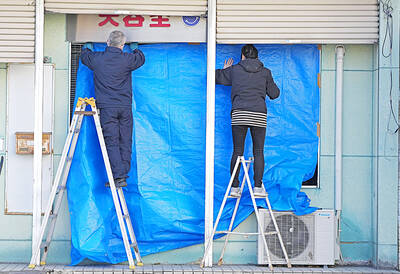A multi-purpose, sea-cleaning vessel is next month to begin operating in the Port of Keelung to remove liquid and solid waste, the Taiwan International Port Corp (TIAC) said on Friday last week.
The state-run port company said that it spent NT$19.11 million (US$652,775) on the vessel, which was delivered from France in June, to improve its ability to keep the port’s waters clean.
Marine pollution at the port mainly comes from the sewage system, TIAC said.
TIAC dispatches personnel twice a day to scoop up marine waste, with more than 400kg collected on some days, it said.
The new ship is to replace those operations, it said.
With the collection of plastic, hydrocarbons, jellyfish, plants, sewage and other floating waste, the daily processing volume would increase to between 500kg and 800kg, it said.
The vessel has dual-flow technology that allows clean water to be evacuated as water polluted with hydrocarbons is stored, it said.
“Suppose there is an oil spill. The vessel’s cleaning rate of 105m3 per hour would dramatically reduce the use of absorbent cotton and lower the effects on the marine ecosystem,” TIAC chief secretary for the Port of Keelung Chen Shih-hung (陳世鴻) said.
The vessel would also support essential services at the port, including towing, firefighting, dock cleaning, and transporting equipment and personnel, Chen said.
TIAC is testing the vessel’s functions and training personnel to operate it from next month, he said.
TIAC plans to import a second multi-service, sea-cleaning vessel next year to replace ships used by port maintenance personnel, Chen said.
Like garbage trucks, they would broadcast music to warn other vessels that they need to avoid interfering with their operations, Chen added.

Taiwanese were praised for their composure after a video filmed by Taiwanese tourists capturing the moment a magnitude 7.5 earthquake struck Japan’s Aomori Prefecture went viral on social media. The video shows a hotel room shaking violently amid Monday’s quake, with objects falling to the ground. Two Taiwanese began filming with their mobile phones, while two others held the sides of a TV to prevent it from falling. When the shaking stopped, the pair calmly took down the TV and laid it flat on a tatami mat, the video shows. The video also captured the group talking about the safety of their companions bathing

US climber Alex Honnold is to attempt to scale Taipei 101 without a rope and harness in a live Netflix special on Jan. 24, the streaming platform announced on Wednesday. Accounting for the time difference, the two-hour broadcast of Honnold’s climb, called Skyscraper Live, is to air on Jan. 23 in the US, Netflix said in a statement. Honnold, 40, was the first person ever to free solo climb the 900m El Capitan rock formation in Yosemite National Park — a feat that was recorded and later made into the 2018 documentary film Free Solo. Netflix previewed Skyscraper Live in October, after videos

Starting on Jan. 1, YouBike riders must have insurance to use the service, and a six-month trial of NT$5 coupons under certain conditions would be implemented to balance bike shortages, a joint statement from transportation departments across Taipei, New Taipei City and Taoyuan announced yesterday. The rental bike system operator said that coupons would be offered to riders to rent bikes from full stations, for riders who take out an electric-assisted bike from a full station, and for riders who return a bike to an empty station. All riders with YouBike accounts are automatically eligible for the program, and each membership account

A classified Pentagon-produced, multiyear assessment — the Overmatch brief — highlighted unreported Chinese capabilities to destroy US military assets and identified US supply chain choke points, painting a disturbing picture of waning US military might, a New York Times editorial published on Monday said. US Secretary of Defense Pete Hegseth’s comments in November last year that “we lose every time” in Pentagon-conducted war games pitting the US against China further highlighted the uncertainty about the US’ capability to intervene in the event of a Chinese invasion of Taiwan. “It shows the Pentagon’s overreliance on expensive, vulnerable weapons as adversaries field cheap, technologically